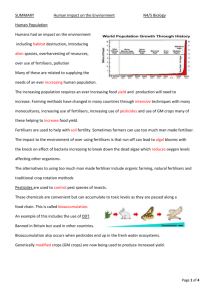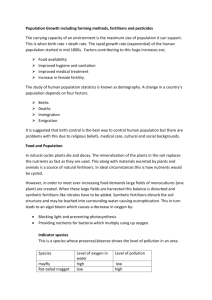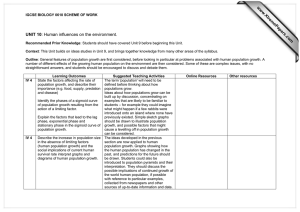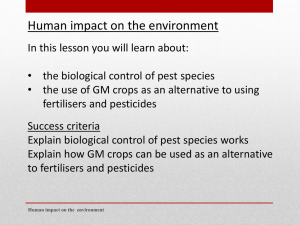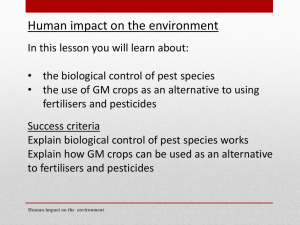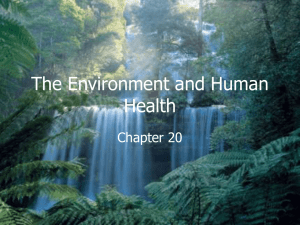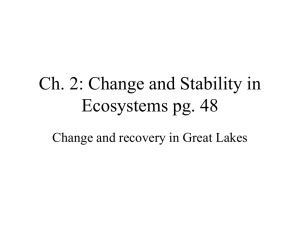Unit 3 Topic 5 Human Impact on the environment
advertisement
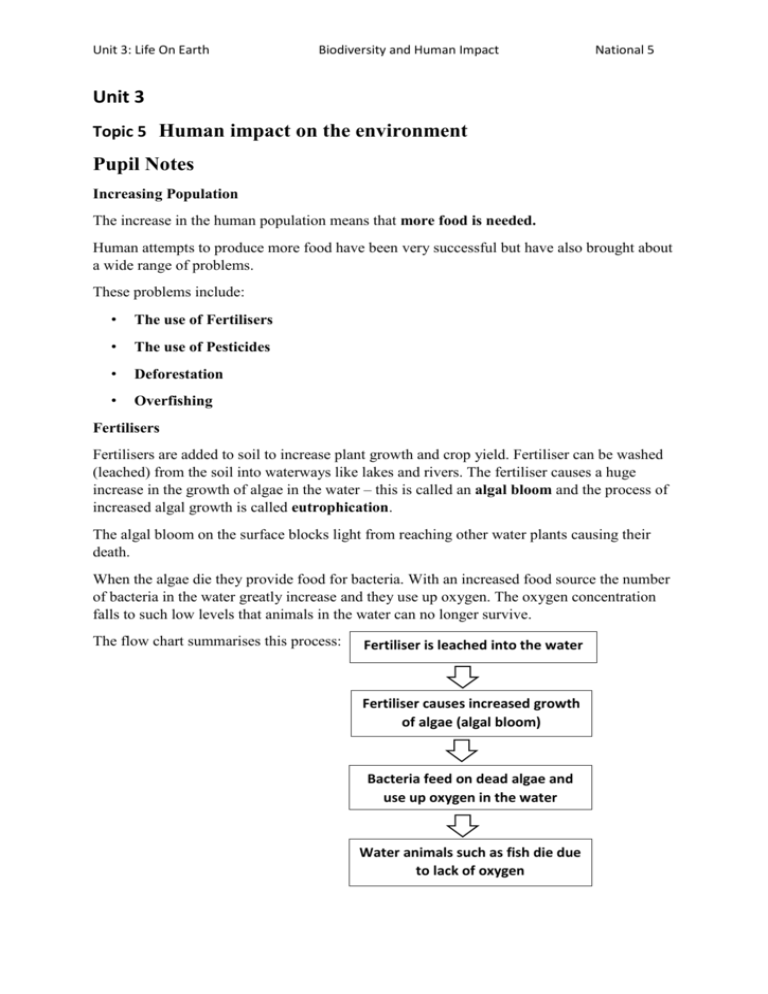
Unit 3: Life On Earth Biodiversity and Human Impact National 5 Unit 3 Topic 5 Human impact on the environment Pupil Notes Increasing Population The increase in the human population means that more food is needed. Human attempts to produce more food have been very successful but have also brought about a wide range of problems. These problems include: • The use of Fertilisers • The use of Pesticides • Deforestation • Overfishing Fertilisers Fertilisers are added to soil to increase plant growth and crop yield. Fertiliser can be washed (leached) from the soil into waterways like lakes and rivers. The fertiliser causes a huge increase in the growth of algae in the water – this is called an algal bloom and the process of increased algal growth is called eutrophication. The algal bloom on the surface blocks light from reaching other water plants causing their death. When the algae die they provide food for bacteria. With an increased food source the number of bacteria in the water greatly increase and they use up oxygen. The oxygen concentration falls to such low levels that animals in the water can no longer survive. The flow chart summarises this process: Fertiliser is leached into the water Fertiliser causes increased growth of algae (algal bloom) Bacteria feed on dead algae and use up oxygen in the water Water animals such as fish die due to lack of oxygen Unit 3: Life On Earth Biodiversity and Human Impact National 5 Pesticides Pesticides are chemicals sprayed onto crops to stop them being damaged by a variety of pests such as caterpillars. Pesticides build up over time in the bodies of animals which eat them. Since animals higher in the food chain eat lots of animals lower in the food chain that have already stored pesticides in their bodies, the pesticides become more concentrated along food chains until they can reach fatal levels in the final consumers. e.g. the diagram represents the accumulation of the now banned pesticide DDT in an aquatic food chain Birds 25 ppm Increase of 10 million times in DDT concentration along this food chain DDT in large fish 2 ppm DDT in small fish 0.5 ppm DDT in plankton 0.04 ppm DDT in water 0.000003 ppm (ppm = parts per million) Birds at the top of the food chain were either killed or laid eggs that were not viable. Unit 3: Life On Earth Biodiversity and Human Impact National 5 Indicator Species Indicator species are organisms whose presence or absence indicates the level of pollution in an area – for some organisms, e.g. bloodworms in water, the fact that they are present indicates pollution while for others, e.g. lichens, the fact that they are absent from trees indicates air pollution. Rivers can be polluted with organic waste, e.g. sewage. Bacteria feed on this and use up oxygen causing death of other organisms such as fish. Some of the invertebrate indicator species whose presence indicates polluted or clean water are shown below: Increasing level of pollution Level of pollution Indicator species present Very low Stonefly or mayfly Low Freshwater shrimp Moderate Water louse High Bloodworms Very high Rat-tailed maggot Indicators of Air Pollution Lichens are plants that grow in exposed places such as tree bark. Air pollutants like sulphur dioxide from burning fossil fuels dissolves in rainwater and damages lichens preventing them from growing. This makes lichens natural indicators of air pollution. In places where no lichens are growing, this is often a sign that the air is heavily polluted with sulphur dioxide. Unit 3: Life On Earth Biodiversity and Human Impact National 5 Biological control Biological control of pests may be used as an alternative to controlling them by use of chemical pesticides. In biological control, a natural predator or parasite of the pest is introduced to the area affected by the pest. These will then kill the pest and reduce its numbers. The table shows examples of biological control: Pest organism Rabbits Aphids Scale insects Organism used in biological control Myxmatosis virus Ladybirds ladybirds There are potential disadvantages to use of biological control where particularly when the predator is not native to the area and has been introduced to control a pest. These include: 1. Lacking natural predators in the area, the introduced predator’s numbers may increase uncontrollably so that it becomes a pest itself. 2. As well as killing the pest, the introduced predator may kill other harmless organisms and decrease their numbers. Genetically Modified (GM) Crops These are crops that have had genes from other organisms introduced to them to improve their characteristics. Genetically modified (transgenic) plants may be resistant to disease or drought be resistant to herbicides and pesticides grow faster produce new drugs to order have greater nutritional value – e.g. golden rice has been developed to contain vitamin A and is produced in areas where vitamin A deficiency is common Effect of GM crops and biological control on intensive farming Growing large numbers of just one crop species in an area as happens in farming, requires the use of fertilisers and pesticides. It is hoped that biological control will make the need for pesticides by producing crops that produce their own anti-pest chemicals, less pesticides will need to be used Crops may be produced that have less need of fertilisers because they grow faster or are able to use nitrogen in the air.
